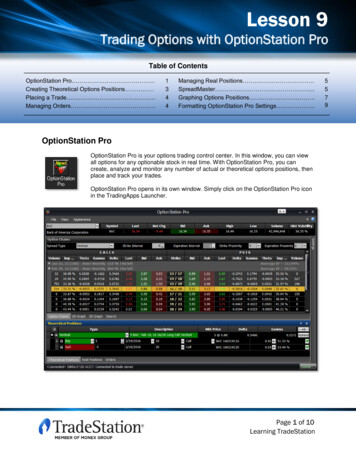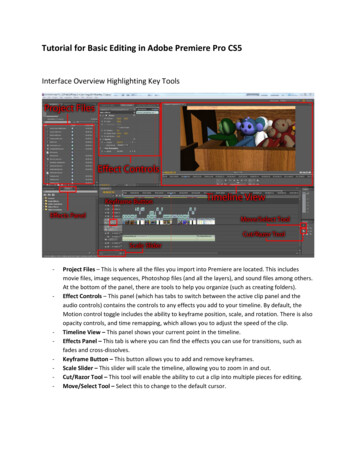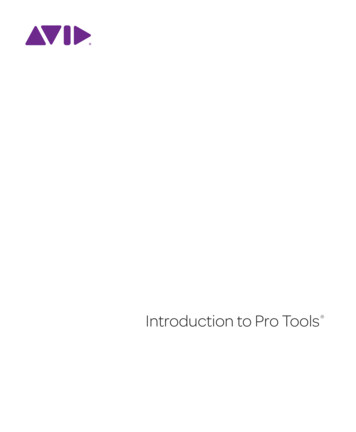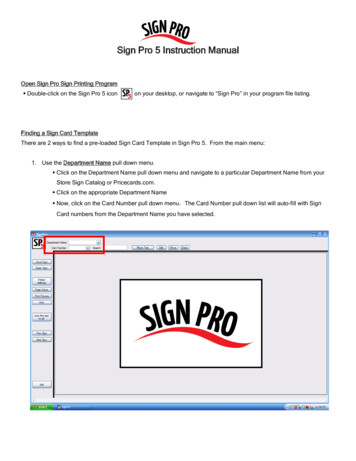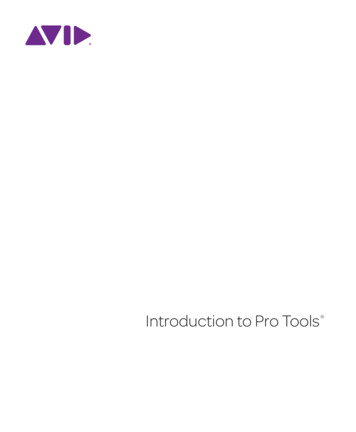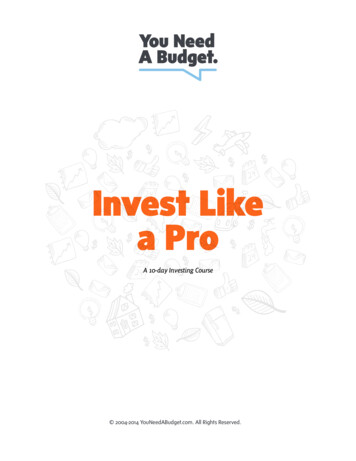
Transcription
!Invest Likea ProA 10-day Investing Course 2004-2014 YouNeedABudget.com. All Rights Reserved.
Day 1: Who This Course is ForIntroductionYou might already know me as "the guy that thinks everyone needs a budget." Or,"that really good-looking guy."Just in case you don't yet know me, a brief introduction.In 2003 I was newly-married and broke. My wife and I didn't own a car, or computer.I had three years of schooling left to obtain my Masters in Accountancy (yes, youcan achieve a Master Level of education in things that boring).I knew my wife and I needed a budget.We set one up, I learned from some early mistakes, and about a year later realizedthat I was onto something. In September of 2004 I launched YouNeedABudget.com,where we teach the best way to to think about and manage your money (and wesell cool software to boot). We're now a household name (at my house). Even myneighbors have heard of it.No, seriously, the YNAB movement has actually grown into something worldwide,with thousands upon thousands of users all over the world. We've experiencedrapid growth, with a fantastic tribe of happy customers. As a team, we are spread allover the world, delivering superb customer service, and high-quality software andinstruction to anyone that will let us tell them over and over again that they.need abudget.I used to be a CPA, so I used to know what I was talking about ;) I'm passionateabout personal finance because it affects every other aspect of your life. I have awife (same one I mentioned above), and five children. If you have any ideas on howI could fill my spare time, I'd love to hear it, because man, I'm really struggling withthat. Kidding. But when I do have spare time, I'm learning the piano, making divotart on the golf course, gardening, and treating my body as a work of art, by doingsome CrossFit.
Why an Investing course?Because you think it's a lot harder than it actually is. Because investing scares you,and it shouldn't. Because you should be investing and you aren't. Because you'reinvesting incorrectly and it's costing you a lot of money.Because the average savings of a 50-year old is 43,000.Because 80% of people ages 30-54 believe they will not have enough money toretire.This Course is For You if:You're a "YNABer."I've created this course for you. I'm operating under the assumption that yousubscribe to the "You Need A Budget" (YNAB) way of managing their money. In aword, you: ! Give every dollar a job. You spend intentionally, without guilt, and accordingto your values.Save for a rainy day. You look ahead and anticipate larger, less-frequentexpenses. You break those up into smaller, manageable, monthly chunks.Holiday spending doesn't sneak up on you.Roll with the punches. You recognize that a budget isn't set in stone. You areflexible, and adjust your budget as needed (and wanted!) in order to reachyour goals.Live on last month's income. Or you're working toward it.If those four bullets describe you, or the aspirational you, then YOU are my targetaudience. You have the "budgeting thing" down, and you'd like to expand yourfinancial knowledge to other aspects of the personal finance realm.You want to invest correctly (and enough!), but have ZERO interest in the complexstuff.This course is for you if you want to make sure you are investing enough, andinvesting correctly, but you have no desire whatsoever to delve into the complexstuff.
You and I are both on the same page then. If there's a topic that's getting a littlehairy, I may even warn you beforehand, letting you know you can skip it. All in allthough, I'm going to filter out all of the complex stuff. Complexity in the investingworld serves one evil purpose: it paralyzes you. The complexity kills yourmomentum, suffocates your confidence, and adds no value whatsoever when itcomes to the performance of your investments.[Enter record-stopping screeching sound here.]Did you catch that last sentence? Your level of investment knowledge, once beyondthe levels we'll discuss in this course, will not help your investment performance.Warren Buffet, the greatest investor of all time, said it best:".the active investors will have their returns diminished by a far greater percentagethan will their inactive brethren. That means that the passive group - the 'knownothings' - must win."I'm a "know-nothing", and I want you to join me! When you discover the amountof time I spend managing my investing (a few hours per year), you'll want to be aknow-nothing as well.You're ready to take action.This course is for you if you're ready to take action. Action in this case, means you'llhave set up an investment account, and will have put it on autopilot.Some of you aren't doing any investing at all, and we'll change that. You'll beinformed, you'll understand what it is that you're doing, and you'll understand whyyou're doing it.The rest of you are already doing some investing, but you want to make sure you'redoing so correctly. You'll benefit from this course very much as well.
Day 2: Why Should You Invest?We're going to spend eight more fun-filled days talking about the ins and outs ofinvesting. Putting yourself through this course begs the question:"Why should you invest?"I mean, honestly, is it just because your dad, or uncle, told you that investing is theway to go? Is it because you're on the elliptical at the gym and your eyes meanderover to your neighbor's TV where the talk is stocks, P/E ratios, markets, andETFs.and you wonder if you're not missing something important (or sexy?!)What you'll learn in this course won't impress anyone anyway. Imagine thisconversation between you and your friend (that thinks investing is sexy andsophisticated):Friend: "So, do you invest?"You: "Yeah. I set up an account and have 125 auto-invested each month."Friend: "Yeah!? What stocks are in your gameplan?"You: "All of them."Friend: "Yeah, yeah I get it. Diversify. Where do you think the market's headed?"You: "I'm pretty sure the market will move either up or down."Friend: "Ha! Yeah, totally. right. I read ya."At that point your friend will choose another topic of stimulating conversation.The following are all reasons NOT to invest. If your primary reason is any of these,re-evaluate your reasoning. You should NOT invest if:You want to make quick buck.You think the market's going to "make a move."Your uncle/aunt/dad/brother/neighbor has been talking up some opportunity thatwon't be around much longer.
You don't understand what you're investing in.You don't have a clear goal, with a firm timeline.You are afraid (this course will help that).Those are all reasons NOT to invest. But what is a great reason TO invest?In the end, there's only one reason to invest: to buildwealth.You can cut it any way you like. You can say that you want to invest to supportsocially-responsible companies, or to fund your children's education, or just to beable to retire and not worry about money. But the root of the idea, the real goal ofinvesting, is to build wealth.You greedy Rich-Dad-Poor-Dad-Reading, Scrooge-McDuck-Swimming-in-Money,Daddy Warbucks wanna-be!Nah, I'm just sort of kidding. The type of wealthy person I'm talking about, and I'msure the type of wealthy person you and I aspire to be, is the one that lives nextdoor. The one that goes about living their life, and being an excellent steward oftheir many blessings.But understand that wealthy people, by definition, are investors. There are noexceptions to that rule. If you want to be wealthy, you need to be investing. (Wherethe wealthy invest is another topic entirely, but not because it's secret, onlybecause it's so diverse. Their wealth is doing something, and that something istheir investment. Every time.)Speaking of wealthy people living next door, in Thomas Stanley's The MillionaireNext Door, he writes that the average millionaire invests almost 20% of theirincome. What percentage of your income are you investing? That number is prettyimportant (though it's not the most important, as we'll find out.)The critical element to building wealth is leverage.
But not the leverage you may be thinking about. Heavens no.A lever "amplifies an input force to provide a greater output force." (Thank youWikipedia.) I can't lift a piano for very long if I just squat down and give it the ol'heave-ho, but if I lift it using a lever, I expend a lot less energy, and get the exactsame output. The lever is a simple machine that makes your life easier.In the traditional sense, leverage means that you're borrowing money, investingthat money, and earning a return on your investment greater than the cost ofborrowing. That's not at all how I operate, and you won't hear another word about"other people's money" for the rest of this course, unless I see an opportunity tomock it.Most of you are familiar with Rule One of the YNAB Method: Give Every Dollar aJob. Some of those dollars go off and buy groceries, some feed your hobby ofartistic blacksmithing, and some. some of those dollars are your levers.When you invest, you're leveraging your money. Your money basically goes outand does work for you. It's beautiful. They're the easiest employees to manage.They never talk back. They always stay on task. And they recruit other employeesto keep doing the same thing. When you build wealth, you are leveraging yourmoney. Period. There's no other way around it.The end goal is to have so many little dollars out there, recruiting other dollars, thatyou just sit around in your underwear watching your soaps. Or something else. Butat least you have the option. ;)Wealth is a super-boring motivator.I mean, snooze alert.Normal Person: "Hey, what drives you? What gets you up in the morning?"Boring Person: "Money."Normal Person: "I see." [looks off and to the left, suddenly rememberingsomething very important that must be taken care of this instant.]
I think I used to be motivated purely by money. I would plan, scheme, and projecthow I could retire before I turn 45. It was all about the nest egg.That was all fine and good until my first child. The lesson was reinforced with thesubsequent four children thereafter.Wealth just doesn't bring joy. Beyond the levels necessary to survive, and livecomfortably (I recognize the wide definitional chasm that word introduces, butchoose to pass.), wealth is not directly correlated to happiness. In fact, researchersat Princeton studied just that. While the "comfort level" was dependent on thesurvey respondent's location, when it all shook out, it turns out that beyond about 75,000 we just don't find much more happiness.I don't say this to drive you completely away from using raw wealth as yourmotivator--only to perhaps give you some food for thought.What could your wealth do? That is an exciting question.What could you DO with your wealth?RetirementThe obvious one is that you could retire. Make sure you define your retirementbeyond a simple amount, or an age. You'll want to retire with purpose, and thatpurpose will be realized because you're independently wealthy.Just this morning I was reading job applications for a Quality Assurance position onthe YNAB Team. One of our standard interview questions is to ask, "What do youwant to learn next? And what do you want to learn after that?"Reading these job applications is quite time-consuming, because I'm constantlysent off on informational treasure-hunting tangents. "Wait, what is that they want tolearn? I want to learn that!" This happens to me again, and again. We have aspiringwoodworkers, linguists, mechanics, blacksmiths, gardeners, musicians. One ofthe reasons I invest for my future is so I can have more time to pursue my owneducational endeavors. I find that motivating.
The same researchers at Princeton that settled on the 75,000 "happinessnumber", recommended that we spend less on material items (which don't increaseour happiness), and more on experiences, which do. What experiences could youhave, or share, with your wealth? I find that question motivating.EducationOne very common reason to invest, is to help your children pay the (skyrocketing)cost of higher education. Education often falls under the "investing" umbrellabecause the timeline is long (18 years until your child heads off to college), andprobably because there are lots of fancy acronyms and cryptic numbers (ESA.529.) you need to decode in order to feel like you can even get going in thisregard.I personally am not completely sold on the idea of helping my kids with theireducation. I'm not against it.I'm on the fence. (I recognize that if I'm going to helpthem, I should start sooner rather than later, so this is a bit of a quandary for mepersonally.) At the moment, Julie and I are more focused on providing them a verysolid K-12 education, and teaching them how to work. Again, I have nophilosophical reasons behind this, but I thought I would just let you know where Ipersonally stand. Your mileage may vary greatly from mine. Cool.WeddingsSay what? That's right. Weddings cost a small fortune. So you need to have a smallfortune saved.My friend, Ramit Sethi, in his book I Will Teach You To Be Rich, makes me want mydaughters to elope:"The average American wedding costs almost 28,000, which The Wall StreetJournal notes, is 'well over half the median annual income in U.S. households.'"Weddings are NEVER considered a viable investing goal, which is too bad,considering the time horizon for weddings is (hopefully) 40 years or so. I'm kidding.Eh, not really. Dang. I'm not sure on this one. I have two daughters. One is five,going on fifteen. I'll bite the bullet and assume they'll marry when they're 25. Thatgives me 20 years to save 56,000. And I'm ignoring inflation. I grabbed my
TI-30XA just now (it sits on my 'strong side', like a trusty sidearm) and calculatedthat I'll need to save 233 per month. Not happening.However, if I treat the wedding savings as an investment, and follow the principleslearned in this course, I need to save 108 per month. Doable. But still ludicrous.Can we please move on? Yes, let's.CarsUnless you're Jay Leno, a car is not an investment. However, if you start followingsome sound investing principles, you'll be paying cash for cars for the rest of yourlife. (I'll mention some terms in here, like time horizon and return on investment,that we'll delve into later.) It goes like this:You purchase a clunker for 2,000. Spend 100 on repairs each month (on average),and "invest" a 200 car payment that you make to yourself. Since clunkers don'treally depreciate, at the end of two years, you trade in your clunker for 2,000 andadd the 4,800 you saved, and trade up to a 6,800 vehicle.You're now driving a 6,800 vehicle. You spend 70 on repairs each month (onaverage), and "invest" a 230 car payment ( 200 you were already paying, plus the 30 of repairs you don't have to make because your car is more reliable) that youmake to yourself. At the end of two years, you trade in your car for 6,000 and addthe 5,520 you saved, and trade up to a 11,520 vehicle.Things are looking pretty good. Notice that I haven't mentioned an investing timehorizon, or a return on investment. The reason being that since you were onlysaving that money for two years, investing it probably wouldn't have been thewisest move.BUT, now you have a five-year horizon because you have a pretty nice, reliable carto drive. You end up with 50 of car repairs on average each month, and you investthe 250 exactly the way I teach in this course (you take into account your timehorizon, you diversify, etc.). Where did the 250 come from? You're saving 50 permonth in car repairs, and funneling that money over to your car investment. Sohow does this shake out? At the end of five years, you trade in your vehicle for
10,000 (there was some depreciation), and add the 17,400 invested, and trade upto a 27,000 vehicle.With cash.The key in all this, is to purchase that clunker in the beginning, and start treatingyourself like the lender-dutifully making payments to yourself. The magic happenswhen you turn 15,000 of payments into 17,400, by way of a six percent return oninvestment.Investing should be goal-driven.What the previous examples illustrate is that your investing should be goal-driven.You should not be investing for any other reason, except to reach a specific, wealthbuilding goal.When it comes to investing, you need concrete goals. We'll get into this in moredepth as we discuss "Winning the Investment Game", but with concrete goals, youwant to focus on what you control concretely-the amount you invest.Remember learning about SMART goals in that time management seminar youwere late to? SMART goals are:! ollow those guidelines as you set your investing goals. For instance:I will invest 125 (SM) each month (A) into my investment account so I can purchasea new car (R) in five years (T).I will double (SM) the percentage I'm investing for retirement within 36 months (AT),so I can take greater advantage of my company's 401k match (R).
On my first daughter's 18th birthday (T), I will destroy all copies (M) of My Bride andban the viewing of Wedding Makeover (S), so I can prevent 50% of wedding costs,and more readily manage expectations (R). I'm the dad (A).In the end, just like your day feels wasted if you don't have clear tasks toaccomplish, your investments can easily be wasted if there's no specific target toreach. If you don't have a specific investment goal in mind, you likely 1) won't getstarted, 2) won't invest enough and 3) won't continue. You'll be an In 'n Outinvestor, and while the burgers are good (and shakes even better), you can't do thatand win in the investment game over the long haul.!
Day 3: Investment GrowthWe've discussed the Why behind investing (to become obscenely wealthykidding!), so today we're going discuss exactly HOW that happens.I'm still not going to mention stocks, ETFs, mutual funds, or expense ratios. We'llsave that for NEVER. Well, almost.You invest to grow your wealth."Jesse, we know! You beat that dead horse all yesterday!"It's true, I did. We talked a lot about wealth, and why you might want a modestamount of it. Today, we'll talk about the other major part of that statement: growingthat wealth.I have this tall grass in a portion of my front yard. When we first put the stuff in, itgrew modestly. The diameter of the grass was probably about eight inches in anyone spot. The grass has now had four years to grow, and it's killing the otherbushes. It's twice as tall, and about four times the diameter that it once was.And the kicker is that its rate of growth is increasing. You may say that my grass iscompounding.For those of you that aren't familiar with the concept of compound growth, I giveyou a very popular tale (hat tip: Wikipedia):When the creator of the game of chess showed his invention to the ruler of thecountry, the ruler was so pleased that he gave the inventor the right to name hisprize for the invention. The man, who was very wise, asked the king this: that forthe first square of the chessboard, he would receive one grain of rice, two for thesecond one, four on the third one, and so forth, doubling the amount each time.The ruler, arithmetically unaware, quickly accepted the inventor's offer, even gettingoffended by his perceived notion that the inventor was asking for such a low price,and ordered the treasurer to count and hand over the rice to the inventor. However,when the treasurer took more than a week to calculate the amount of rice, the rulerasked him for a reason for his tardiness. The treasurer then gave him the result ofthe calculation, and explained that it would take more than all the assets of the
kingdom to give the inventor the reward. The story ends with the inventorbecoming the new king.(A bit more digging in Wikipedia yielded the fact that the inventor should have beengiven about 461 BILLION metric tons of rice. A heap of rice larger than MountEverest, and 1,000 times more than the world's 2010 rice production.)Making your investment grow.There are three components to investment growth. I don't care how fancy anyonewants to make investing seem, it all boils down to these three components, in alltheir glory:! The amount of money you're investing.The length of time your money will be invested.The rate your investment is growing (often called an investment's "return").Let's dissect all three. The first two aren't too crazy. The third gets a bit trickier.They're all important, so hang with me!Investment AMOUNTThis is really, really obvious when it comes to lump-sum investing. If you have twoidentical investments, and in one, you put 1,000 and in the other you put 2,000-well, the one with the 2,000 initially invested will have more money.Thank you.And, of course, if you're investing over a period of time, the more money youinvest, the bigger your investment will be--all else equal.I fear this day will be full of similarly obvious statements.Of course, you control how much you invest, and understanding what you controlin the investment game is actually a really big deal. We'll get into that in a seriousway with Day Five.!
TIME for the Investment to GrowBack to my yard care woes, if I let the weeds go unattended for a week, it's not toobig of a deal. If I let them go for a month, I have Weedageddon on my hands, andwould rather uproot the family and move into a new home. (With investing, Isuppose you want this Weedageddon, for yard care, not so much.)When it comes to investing, time is your best friend, and your worst enemy.Let's start with an investment goal: You want to have 500,000 saved by the timeyou're 65:Starting when you're 30, you'll need to put away 218 per month. Wait 10 years,until you're 40, and your required monthly investment more than doubles, to 526.Or maybe you don't start at 40, and you wait until you're 50. your paymentalmost triples if you wait another ten years.Let's look at this another way. You're 30 years old, and you decide to invest 200each month. Your investment returns 8% per year. You stop investing anyadditional money when you turn 50 (you went through a midlife crisis and endedup with a 200 car payment for a Chrysler LeBaron--hey, don't ask me, you did it).Your buddy mocked you when you were 30 years old, because you were investingto win, and opted not to see Titanic nine times in the theater. In other words, youwatched your pennies. Well, your buddy turns 50 as well and hasn't invested adime. He sees you in your sweet Chrysler, (falsely) assumes you're rolling in dough,and decides he better catch up. So he triples your monthly contribution and startssaving 600 every month, like a crazy man. He no longer plays golf, eats out, orgoes to the movies. Same eight percent return.Fifteen years later, you still (surprisingly) have the LeBaron, and a retirement nestegg of almost 400,000. Your buddy, who hasn't seen a movie in 15 years, has anest egg of just over 200,000.That is the power of time. And that is also the last time I'll mention Titanic, orChrysler LeBarons.
Time is something you will never get back. I want you to feel some serious urgencyhere. Time is your greatest ally with investing! If you're 40, and you haven't setaside a penny, then guess what? Let's get started! Do NOT throw up your handsand tell me you've missed your investing window. That's complete and utternonsense, and I won't have you thinking that way.You may have missed yesterday's investing window. But you haven't yet missedtoday's. Don't harbor the attitude that you've missed out, because in five years,you will have missed out on five years of growth.(I was about to say that you'd be exactly where you started if, five years from now,you still had decided not to begin investing earnestly. That's wrong though. If youwait five more years, then you're even further behind than you are now.)You are on a treadmill where the speed increases on a regular basis. The only wayto slow it down is to start running.We have six days left in this course. Day Nine is where I discuss STARTING. Be readyto start.Your Investment GROWTH (rate of return)There is no shortage of writing when it comes to the rate of return on yourinvestments. I know we've hit on it a little bit with the above examples, but just tomake sure we're all super clear on it: Your investment rate of return is the rate atwhich your investment is returned to you (usually expressed annually).I warned you earlier that I may throw out some pretty obvious stuff today.
So when someone says they're "earning 10% with some super mutual fund," whatthey're really saying is that for every dollar they put in, in one year it gives themback 10 cents ( 1.00 * 10%).You may be thinking that it would take ten years to earn back your entireinvestment, if your rate of return is 10 percent. Nope, because the investmentcompounds. Remember, every dollar your investments recruit also recruit newdollars.(Note: a quick way to figure out how long it would take to double your investedmoney, is to divide 72 by the rate of return you're getting. It's not totally accurate,but it's good enough to give you a ballpark to work with. If my rate of return is 8%,my money will double in (72 / 8 9) nine years.)Understanding your rate of return is critical when determining your investmentgoals. Unfortunately, the rate of return is a bit elusive. It's best to understand theunderlying components of your rate of return, so you can focus in on what you cancontrol more easily.Growth (positive)This is not the place to get into the reasons why investments become inherentlymore valuable, but let's just boil it down to this: Your investment rate of return goesup if the value of your investment goes up. Cool? So you buy a house worth 200,000 and then you have it appraised and it's worth 220,000. You had a rate ofreturn of 10% ( 20,000 growth / 200,000 investment).It makes sense that growth plays a role in your investment's rate of return :) As amatter of fact, growth is the only potential positive for your rate of return. The restof the factors can only be zero, at best.It may be surprising to you what other factors in your investment's rate of returnalso play fairly significant roles!!!!!
Taxes (negative)Don't get me started.The tax situation changes like the weather. Taxes are your life's single biggestexpense. Don't take them lightly. Minimize them as much as possible, just as you'dtry and minimize what you pay for a gallon of milk, or your next car. (Except bigwins with tax minimization strategies are much bigger than big wins purchasingmilk.)We can't predict the future, so predicting future tax rates on your investments is aguessing game, at best. Tomorrow we'll discuss various investment vehicles (don'tworry if you don't know what I'm talking about) and some tax strategies that comealong with them, but for now, let's just leave it at this:Taxes negatively affect your investment's rate of return. If you predict yourinvestment will return 10%, but your state and federal governments tax you at acombined 30%, then that means you get to keep 70% of your return (100% - 30%in taxes). So your rate of return will be 7% (10% * 70% 7%).Inflation (negative)My grandpa loves to tell the story (again.and again.) of how he would take aquarter, ride the bus downtown, buy two candy bars, see a movie, and ride the busback home. For a quarter!A quarter doesn't buy much at all these days. That's inflation."A dollar just doesn't buy what it used to."It's just the purchasing power of the dollar going down over time. That's inflation.So in 30 years, when your investments are all just spilling out of your pockets,you'll want to make sure you have enough of those investments at the futuredollar's value.The easiest way to figure inflation into a rate of return is to subtract it. Inflation since1900 has averaged about 3 percent. That's right, if your cash is in a savings accountearning 1 percent, you're being taxed on that 1 percent and then inflation is ravagingit. You're actually losing money :(
With that 10 percent return we've been using, 3 percent went to taxes, and 3 percentto inflation. We're down to 4 percent. Woah.Transaction Fees (negative)It takes money to make money, and Wall Street likes to take your money in order tomake their money. When you hop over to a broker to purchase a stock, they'llcharge you a transaction fee. When you sell that stock they'll charge you atransaction fee.Let's say you want to invest 500 to get started. If you purchase it through a normalonline broker, such as Scottrade, they'll charge you 7. Factor that 7 into your firstyear's rate of return, and you start in the hole by 1.4 percent ( 7 fee / 500 initialinvestment).Then sell that initial investment for 600 and you pay another 7, or 1.2 percent ( 7fee / 600 investment sold).If you are stuck in a situation where you have to pay transaction fees, it's best ifyour investment amounts are larger.Most brokers will charge you a transaction fee, but there are ways to avoid them(we'll talk more about that when we talk about STARTING).Investing FeesWe covered fees that you may incur as you transact (buy or sell), but there are alsofees you incur ongoing. These are often called expense ratios. If the fund you'veinvested in has 1 billion in assets, and 10 million in expenses (paying managers,paying transaction fees, paying for stamps, etc.), the expense ratio would be onepercent.Expense ratios tend to be more expensive as the underlying investments becomemore extravagant. I personally avoid mutual funds all together and invest where theexpenses are even lower (about .10 percent, or 10 percent of a percent).Financial Advisor Fees (negative, with a caveat)Don't confuse financial advisor fees with the expense ratio that is partially used topay managers of a mutual fund. Many financial advisors wi
You greedy Rich-Dad-Poor-Dad-Reading, Scrooge-McDuck-Swimming-in-Money, Daddy Warbucks wanna-be! Nah, I'm just sort of kidding. The type of wealthy person I'm talking about, and I'm sure the type of wealthy person you and I aspire to be, is the one that lives next door. The one that goes about living their life, and being an excellent steward of





